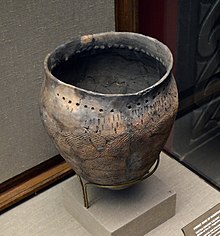Netted Ware culture
| Alternative names | Textile Ceramic culture |
|---|---|
| Geographical range | Finland, northwestern Russia |
| Period | Bronze Age |
| Dates | 1900 BCE – 500 BCE |
| Preceded by | Volosovo culture, Fatyanovo–Balanovo culture |
The Netted Ware culture (also called Textile Ceramic culture) was a Bronze Age culture in northeastern Europe that extended from Finland to the upper Volga region in Russia.[1][2]
Origins

The Netted Ware culture emerged around 1900 BCE with the arrival of the
Hypothetical linguistic affiliation
The spread of the Netted Ware culture has been linked to the dispersal of early forms of the
References
- ^ a b Carpelan, Christian; Parpola, Asko (2001). "Emergence, contacts and dispersal of Proto-Indo-European, Proto-Uralic and Proto-Aryan in archaeological perspective". In Christian Carpelan; Asko Parpola; Petteri Koskikalli (eds.). Early contacts between Uralic and Indo-European: Linguistic and archaeological considerations (PDF). Mémoires de la Société Finno-Ougrienne 242. Helsinki: Société Finno Ougrienne. pp. 55–150. Retrieved 7 Dec 2022.
- ^ hdl:10138/311944.
- ^ .
